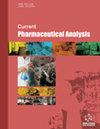用互补分析方法识别治疗性单克隆抗体中由方法引起的伪差和轻链 C 端延伸序列变异
IF 1.5
4区 医学
Q4 PHARMACOLOGY & PHARMACY
引用次数: 0
摘要
背景:在开发治疗性单克隆 IgG4 抗体(mAb-X)的过程中,在十二烷基硫酸钠毛细管电泳(CE-SDS)中观察到了非典型峰。根据以往的文献报道,非典型峰可能由多种因素引起,如翻译后修饰(PTMs)、方法引起的假象、样品降解和序列变异。由于 mAbs 结构的高度复杂性和 CE-SDS 的局限性,全面分析非典型峰一直是一项挑战。目的:在此,我们开发了一种利用互补分析方法确定非典型峰成因的策略。方法:该策略包括优化还原 CE-SDS 方法以评估分析方法引起的伪影,排除潜在的糖化修饰,并利用液相色谱质谱仪 (LC-MS) 鉴定 mAb-X。结果:我们的研究表明,mAb-X 的非典型峰是由方法引起的假象和轻链 C 端延伸序列变异的混合物。结论补充分析方法工具的策略有助于确定未知物种的成因,并在产品和工艺表征中发挥关键作用。本文章由计算机程序翻译,如有差异,请以英文原文为准。
Identification of Method-Induced Artifacts and Light Chain C-terminal Extension Sequence Variants in Therapeutic Monoclonal Antibodies by Complementary Analytical Methods
Background: Atypical peaks were observed in capillary electrophoresis with sodium dodecyl sulfate (CE-SDS) during the development of therapeutic monoclonal IgG4 antibodies (mAb-X). Based on the previous literature reports, the atypical peak may be caused by various factors such as post-translational modifications (PTMs), method-induced artifacts, sample degradation and sequence variants. Due to the high complexity structure of mAbs and the limitations of CE-SDS, acquiring comprehensive profiling of atypical peaks has historically been challenging. Objective: Here we developed a strategy utilizing complementary analytical methods to identify the cause of atypical peak. Methods: This strategy includes optimizing reduced CE-SDS method to evaluate artifacts induced by the analytical method, excluding potential glycation modifications, and utilizing Liquid Chromatograph Mass Spectrometer (LC-MS) to characterize mAb-X. Results: Our study demonstrates that the atypical peaks of mAb-X are a mixture of method-induced artifacts and variants in the C-terminal extension sequence of the light chain. Conclusion: Strategy for complementary analytical methods tools helps to identify the cause of unknown species and plays a key role in product and process characterization.
求助全文
通过发布文献求助,成功后即可免费获取论文全文。
去求助
来源期刊
CiteScore
1.50
自引率
0.00%
发文量
85
审稿时长
3 months
期刊介绍:
Aims & Scope
Current Pharmaceutical Analysis publishes expert reviews and original research articles on all the most recent advances in pharmaceutical and biomedical analysis. All aspects of the field are represented including drug analysis, analytical methodology and instrumentation. The journal is essential to all involved in pharmaceutical, biochemical and clinical analysis.

 求助内容:
求助内容: 应助结果提醒方式:
应助结果提醒方式:


